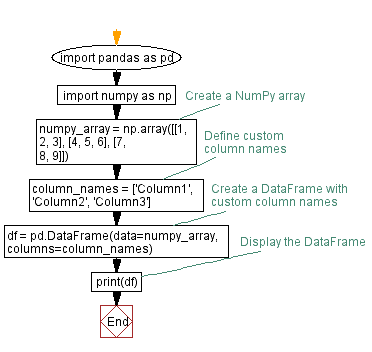Generating a Pandas DataFrame from a NumPy array with custom column names in Python
Create a DataFrame from a NumPy array with custom column names.
Sample Solution:
Python Code:
import pandas as pd
import numpy as np
# Create a NumPy array
numpy_array = np.array([[1, 2, 3], [4, 5, 6], [7, 8, 9]])
# Define custom column names
column_names = ['Column1', 'Column2', 'Column3']
# Create a DataFrame with custom column names
df = pd.DataFrame(data=numpy_array, columns=column_names)
# Display the DataFrame
print(df)
Output:
Column1 Column2 Column3 0 1 2 3 1 4 5 6 2 7 8 9
Explanation:
- Importing Libraries:
import pandas as pd
import numpy as np
Imports the Pandas and NumPy libraries with the aliases "pd" and "np". - Creating a NumPy Array:
numpy_array = np.array([[1, 2, 3], [4, 5, 6], [7, 8, 9]]) Creates a 2D NumPy array named "numpy_array". - Defining Custom Column Names:
column_names = ['Column1', 'Column2', 'Column3']
Defines custom column names in a list named "column_names". - Creating a DataFrame with Custom Column Names:
df = pd.DataFrame(data=numpy_array, columns=column_names)
Uses the pd.DataFrame constructor to create a DataFrame (df) from the NumPy array with specified column names. - Displaying the DataFrame:
print(df)
Flowchart:

Python Code Editor:
Previous: Loading a CSV file into a Pandas DataFrame with Python.
Next: Selecting rows based on multiple conditions in Pandas DataFrame.
What is the difficulty level of this exercise?
Test your Programming skills with w3resource's quiz.
